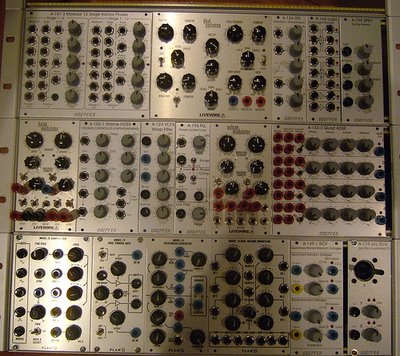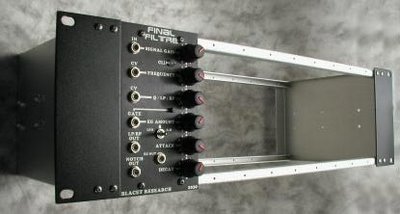 Update
Update: Adding a shot from
this previous post on what this could look like. The shot is an Elby Designs Steiner VCF via cray5656's
flickr set.
Via Grant Richter on the
Wiard list:
"If the public could change their perception of how a synthesizer module must be constructed, we could have a renaisance unlike anything in the past. The single most expensive component in a synthesizer is the aluminum faceplate. There is only one source for turnkey faceplates in the US and they are obscenely expensive. I pay $70 each for 1200 series faceplates. Your only other option involves using 4 different vendors. One to get the metal blanks, one to put the holes in them, another to anodize them and another yet to silkscreen them. Each step is a chance for errors to creep in. Also, there are 5 shipping charges to move everything from place to place or lose the whole batch. Or drop the box...
The people who make printed circuit boards are used to doing most of these operations to a higher degree of precision and more quickly and cheaply than machine shops. If the buying public was willing to accept faceplates made from fiberglass instead of metal, it would open the floodgates to new module designs.
You can hardly see the difference either, the fiberglass is painted and silkscreened just like the metal. Plus fiberglass is lighter and stiffer. I have heard this idea repeatedly from many people, but no one believes people will buy modules with fiberglass faceplates. It is not historical.
There are also design advantages to PC material faceplates. The faceplate can become part of the circuit. Touch switches for triggers or mode selects are essentially free. Things that are expensive in metal, like slots for linear pots or perforated grills for speakers, now cost a few pennies instead of a few dollars.
It is a practical idea, but the world is not yet ready for it."
 flickr by cray5656
flickr by cray5656 flickr by cray5656.
flickr by cray5656. Update: Adding a shot from this previous post on what this could look like. The shot is an Elby Designs Steiner VCF via cray5656's flickr set.
Update: Adding a shot from this previous post on what this could look like. The shot is an Elby Designs Steiner VCF via cray5656's flickr set. flickr by cray5656 aka Ross.
flickr by cray5656 aka Ross. flickr by cray5656.
flickr by cray5656. Via ross healy, aka cray5656:
Via ross healy, aka cray5656:













